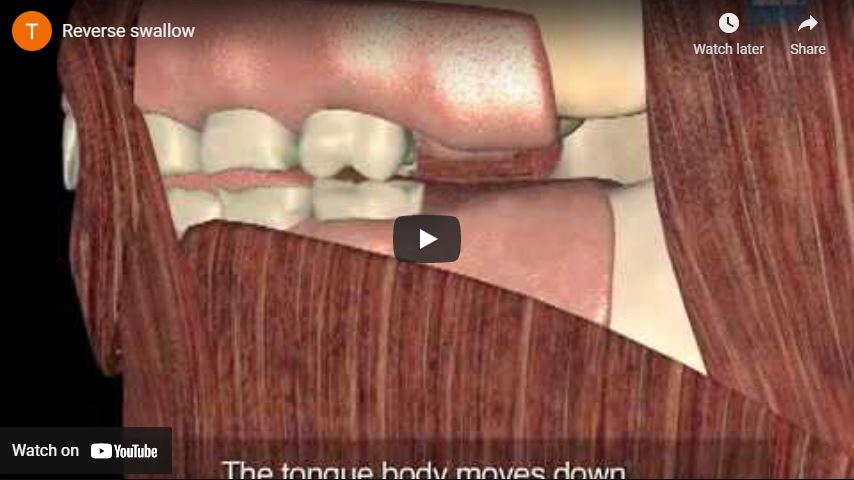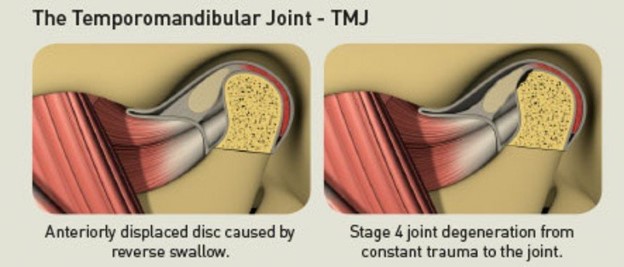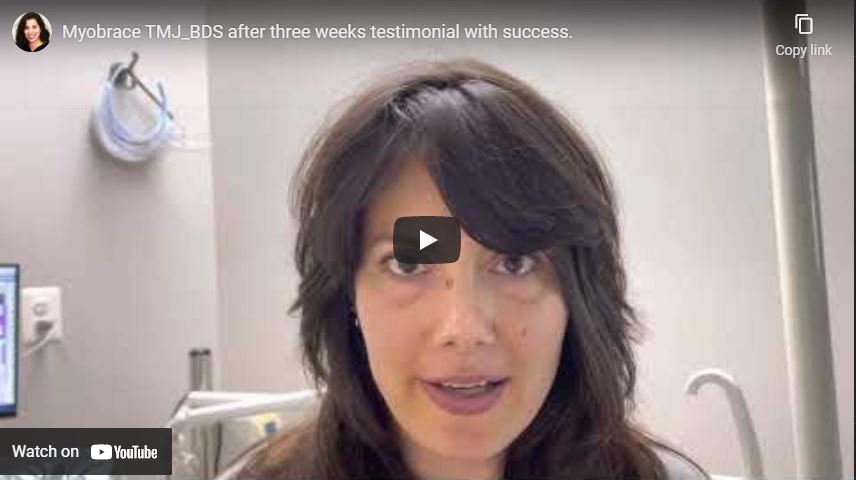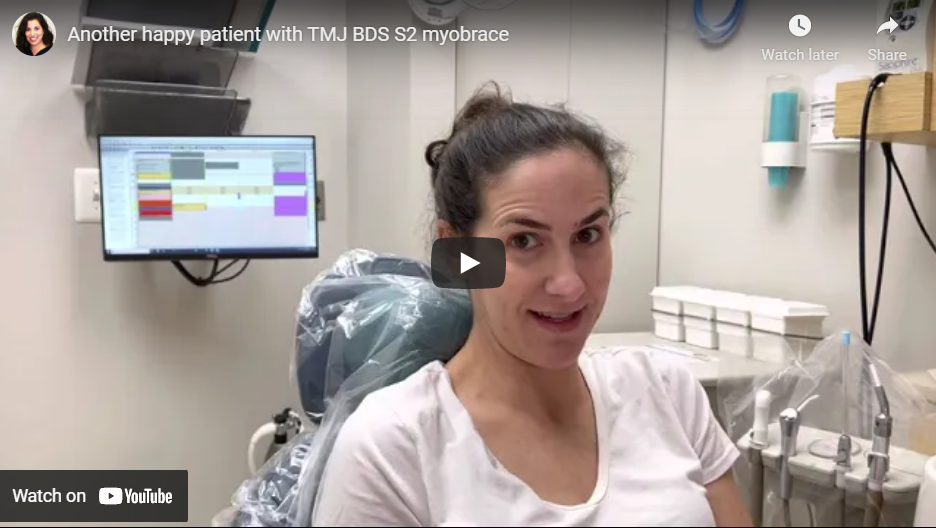This is our patient wearing the TMJ-BDS s2 myobrace. After 3 shorts weeks, all her symptoms that she has had for many years disappeared. Look at her face changes, her jaw is aligned which is makes her face more symmetrical. Her headaches are gone and she sleeps well. Listen to her testimonial below.

The reason Dr. Roca’s treatments are completely different than every office you have visited is because she tries the myobrace on the patient while they are in the office and tests the muscles and TMJ tension before and 5 minutes after trying it on. She and the patient both know right away if their breathing and TMJ body pains are better, and if the appliance places the jaws a neutral position. Before dispensing a myobrace, we do postural testing to determine if the body positively responds to the myobrace and if the patient is a candidate. We take photos before of posture, profile, face, smile, bite with lip spreaders, the cant (standing with tongue depressor between molars), the upper and lower arches and the tongue position.
Dr. Roca likes to start with the TMJ-BDS s2 myobrace whenever possible because it desensitizes the patients and starts to teach them the correct way to swallow and proper nasal breathing. The best part is the appliance pulls the lower jaw forward, allowing the TMJ to repair so the condyle is not pushed back into the fossa.
Patients always come back for their two-week check shocked about how much better they feel and how much better they are sleeping. The headaches are gone and the neck tension is always better.
https://myoresearch.com/en-au/appliances/tmj-system
If Dr. Roca is not convinced the patient feels 99.9 percent better after just 5 minutes, the myobrace is not the treatment for that particular patient. At that point, she usually turns to the POD or the Homeoblock™ appliance to start to heal the TMJ.
Did you know that the fact you are swallowing wrong is the main reason for your TMJ disorder? If you have any chance in improving your symptoms you need to learn to swallow correct.

Temporomandibular joint (TMJ) dysfunction can be caused by many different issues, such as trauma or pathology, but what many do not realize is that the majority of TMJ issues are associated with mouth breathing and poor myofunctional habits. Treatment of TMJ disorder must involve consideration of the airway and correction of poor habits.
Since most conventional treatments overlook this phenomenon, sufferers of TMJ disorder never usually find proper relief and instead learn to manage lifelong symptoms. This is further complicated by the wide range of symptoms that arise from TMJ disorder and breathing dysfunction.
The Temporomandibular Joint (TMJ)
The TMJ is where the mandible joins the temporal bone of the skull. Each time a person chews, speaks, and swallows, the joint moves. Therefore, it is one of the most frequently used joints in the body.

What Is TMJ Disorder?
Temporo-mandibular joint (TMJ) disorder is commonly misunderstood and often goes undiagnosed. It’s an integral part of myofunctional orthodontics because if you have poor oral function (or soft tissue dysfunction) you’ll nearly always have some sort of TMJ disorder.
TMJ disorder was first identified in 1934 by Dr. JB Costen and is a condition that occurs when the TMJs are subjected to excess pressure through misalignment of the teeth, muscles, and jaw. Dr. Costen demonstrated the fact that ear, head and neck pain could be eliminated by correcting an improper bite and removing excess pressure on the TMJs by “opening the bite” with intra-oral splints. These patients become attached to the splint and never get to the root of the problem, using the splint as a band-aid instead of correcting the dysfunction.
The TMJ is quite a complex joint. Many doctors think the joint has a rotational movement, however, Dr. AC Fonder showed that the opening and closing of the mandible pivots around the C1 and C2 vertebrae, meaning that it’s an integral part of cervical function as well. This is why many patients exhibit neck disorders along with TMJ disorder.

Most of the time, the focus is on the joint, even when the symptoms aren’t actually related to the joint. The symptoms are more concerned with the cranio-mandibular muscles (intra-capsular and extra-capsular). Symptoms of TMJ range from a clicking joint to more severe intra-capsular issues. The majority of patients have a wide number of symptoms that affect the neck, head, and shoulders. This can be confusing for the dentist who is not used to treating areas outside of the mouth. In actual fact, however, treatment is still performed internally by correcting the myofunctional habits. Once we learn to use the intraoral muscles and the extraoral muscles correctly instead of abusing the wrong muscles as compensations for the correct ones, patients quickly start to feel so much better.
Research shows most patients have both intra-capsular (related to the jaw joint and bone structure) and extra-capsular (related to the muscles of the face and neck) symptoms.
What Causes TMJ Disorder?
Many dentists think it is just grinding the teeth and advise patients to wear a splint in order to stop teeth grinding, although this is not always a significant factor in TMJ disorder. Any trauma to the joint is going to cause a TMJ dysfunction. Accidents, falls and whiplash injuries are some of the most common contributors to TMJ disorder. It’s so widespread it can’t be just traumatic injury to the joint. It’s understandable that if the jaw sustains a blow, damage can occur, but what about a lifetime of incorrect swallowing patterns and an open mouth posture?
With a correct, normal swallowing there is no distalization of the condyle, but an incorrect swallow and mouth-open posture will distalize the condyle twice in a minute. This is a substantial source of trauma to the joint, and a common cause of TMJ disorder. Mouth breathing, poor growth of the jaws, and incorrect myofunctional habits can cause a reverse swallow as an adaptation. This means the patient swallows using their lower lip, which causes their lower jaw to push back every time the lip muscle activates. As a result, the head of the mandibular condyle is driven upwards and backwards multiple times per hour, traumatizing the joint. As the lower jaw pushes back, it collides with the upper back molar, causing cracks and interferences on the molars, which makes the joint pain worse and ends up causing many dental problems on back molars.
The Treatment Options
If there aren’t any intracapsular issues, then three to six months using The TMJ Appliance® will resolve a lot of the issues. Generally, patients should be reviewed after one and two months to monitor progress. If 50% of the patient’s symptoms have been relieved, then treatment is working.
Why does it work? It unloads the joint, aligns the jaws, brings the mandible forward, corrects midline shifts, corrects tongue position and stops any poor myofunctional habits. The key point to realize here is that we are focusing on myofunctional issues. The TMJ Appliance also prevents tooth grinding. It’s soft, flexible and easy to use.

The TMD appliance (‘D’ for daytime use) was developed as a single-arch, moldable and removable daytime splint that is also suitable if a patient has some missing teeth, or if they display an intra-capsular issue.
The Bruxogard™ was designed for patients who have problems with teeth grinding (bruxing) and who want to “Band-Aid” the joint issue until they can find time to focus on the myofunctional muscle work. At Arlington Smile Center, we would rather treat the root cause of the grinding and eliminate the grinding altogether by treating the sleep-disordered breathing that is ultimately causing the grinding.
The TMJ-MBV™ (Mouth Breather Version) was designed for patients who snore and have trouble with mouth breathing during sleep. The TMJ-MBV has a higher profile than The TMJ Appliance, with large breathing holes.
How Does Orthodontic Appliance Therapy Help?
Orthodontic appliance therapy has shown great promise in helping retrain patients to proper breathing and swallowing practices. By improving physical function through slight repositioning of the jaw patients have seen an improvement in sleep disordered breathing and poor head posture as well as received relief from headaches and muscle pain caused by poor craniofacial development. Treatment plans include working with specialists, including myofunctional, craniofacial and physical therapists as well as ENT doctors to improve patients’ health.
If you have been living with the pain and discomfort described above, we invite you to call 703-237-7622 to discover the benefits that these treatments may bring to your quality of life.


